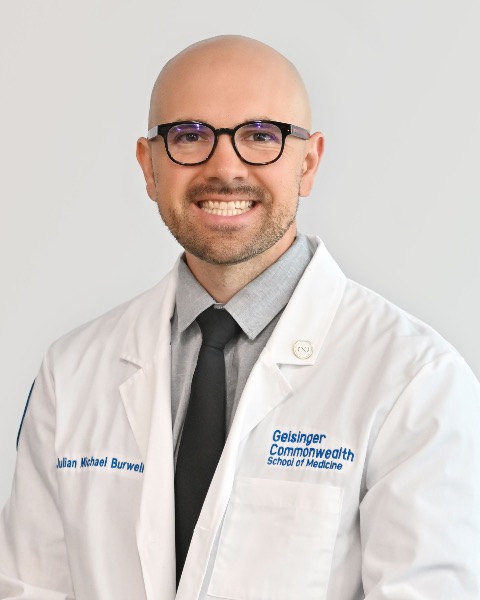Trauma and Critical Care
Delayed Neuroworsening following Moderate to Severe Traumatic Brain Injury
Delayed Neuroworsening Following Moderate to Severe Traumatic Brain Injury

Julian Burwell, MS
Medical Student
Geisinger Commonwealth School Of Medicine
Clarks Summit, PA, US
Presenting Author(s)
Introduction: Neuroworsening (NW) is a debilitating complication of traumatic brain injury (TBI) that contributes to excess mortality and greater rates of medical intervention. Previous studies have focused on early NW (first 24 hours after trauma). Less is known about the etiology and incidence of delayed neuroworsening (DNW) (status changes >24 hours after admission). Our study focused on identifying the dispositional risk factors for DNW following moderate-severe (ms)TBI.
Methods: Retrospective cohort analysis of adults (>16 years old) with primary head trauma and a field GCS score of ≤12 who presented to two Level-1 trauma centers (2019-2023). Data was extracted from the Trauma Quality Improvement Program database and neurologic status exams from EMS though hospital day seven were verified with Electronic Health Record. DNW was defined as GCS decrease ≥2 points not due to intubation/sedation, motor score decrease ≥1 point, new focal neurological deficits, or hemorrhagic progression on head CT beyond 24 hours. Meta for R was used for statistical analysis.
Results: 520 patients met inclusion criteria. DNW occurred in 73 (14.0%) patients, occurring at a mean 2.8 ± 1.4 days post-admission. Risk factors for DNW included SDH (RR 3.96 [2.30-6.80], p< 0.001), multicompartment hemorrhage (RR 4.77 [3.11-7.32], p< 0.001), and cranial fractures (RR 1.65 [1.07-2.54], p=0.022). DNW was associated with higher rates of in-hospital mortality (OR 2.18 [1.32-3.59], p=0.036), ICP monitoring (OR 3.25 [1.92-5.50], p< 0.001), and craniotomy/craniectomy (OR 2.89 [1.63-5.12], p< 0.001). Unlike previous studies, age ≥60 (RR 1.10 [0.72-1.68]), pre-trauma warfarin use (RR 0.99 [0.37-2.64]), and polytrauma (RR 1.10 [0.71-1.71]) were not associated with DNW in our cohort.
Conclusion : DNW was strongly associated with the presence of SDH, multicompartment hemorrhage, and skull fracture in this cohort. The incidence, injury-patterns, and imaging data presented here aim to inform future models that will reduce excess mortality in patients with msTBI.
Methods: Retrospective cohort analysis of adults (>16 years old) with primary head trauma and a field GCS score of ≤12 who presented to two Level-1 trauma centers (2019-2023). Data was extracted from the Trauma Quality Improvement Program database and neurologic status exams from EMS though hospital day seven were verified with Electronic Health Record. DNW was defined as GCS decrease ≥2 points not due to intubation/sedation, motor score decrease ≥1 point, new focal neurological deficits, or hemorrhagic progression on head CT beyond 24 hours. Meta for R was used for statistical analysis.
Results: 520 patients met inclusion criteria. DNW occurred in 73 (14.0%) patients, occurring at a mean 2.8 ± 1.4 days post-admission. Risk factors for DNW included SDH (RR 3.96 [2.30-6.80], p< 0.001), multicompartment hemorrhage (RR 4.77 [3.11-7.32], p< 0.001), and cranial fractures (RR 1.65 [1.07-2.54], p=0.022). DNW was associated with higher rates of in-hospital mortality (OR 2.18 [1.32-3.59], p=0.036), ICP monitoring (OR 3.25 [1.92-5.50], p< 0.001), and craniotomy/craniectomy (OR 2.89 [1.63-5.12], p< 0.001). Unlike previous studies, age ≥60 (RR 1.10 [0.72-1.68]), pre-trauma warfarin use (RR 0.99 [0.37-2.64]), and polytrauma (RR 1.10 [0.71-1.71]) were not associated with DNW in our cohort.
Conclusion : DNW was strongly associated with the presence of SDH, multicompartment hemorrhage, and skull fracture in this cohort. The incidence, injury-patterns, and imaging data presented here aim to inform future models that will reduce excess mortality in patients with msTBI.

.jpg)